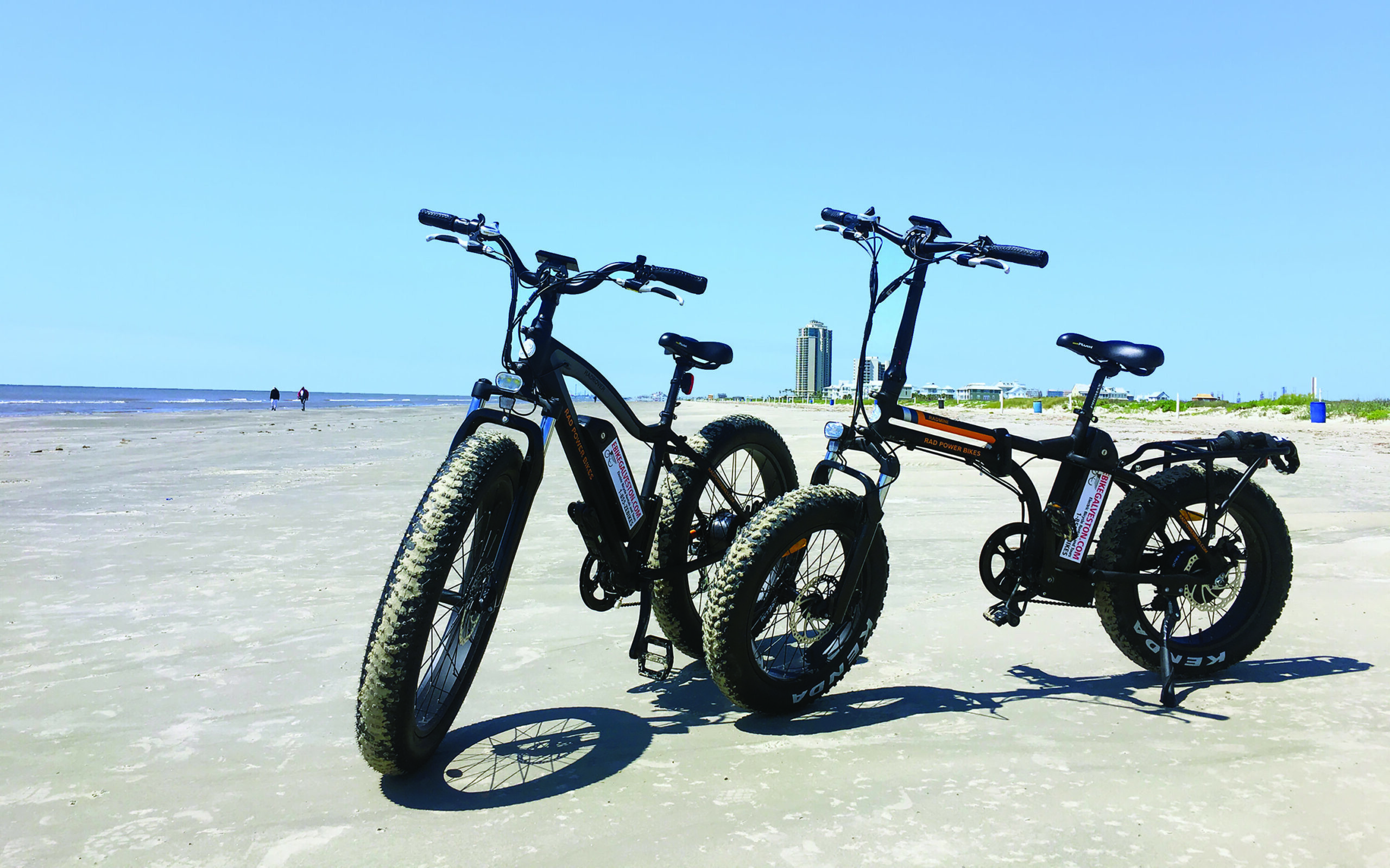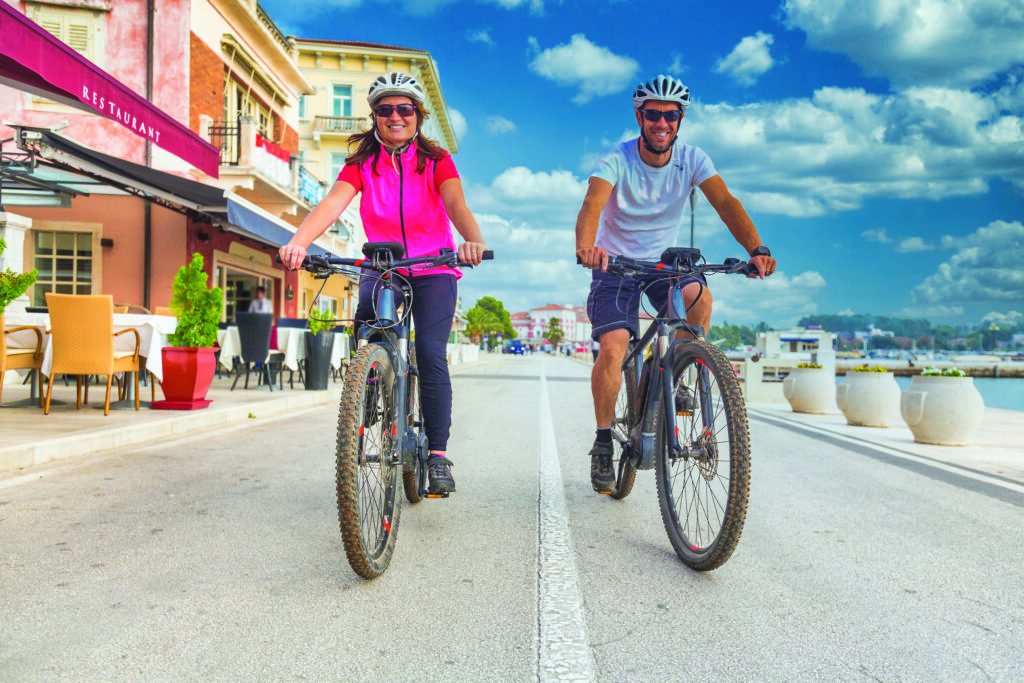‘open up possibilities’
By MeLinda Schnyder
In Austin, Texas, we pedaled a bicycle through downtown neighborhoods while listening to a songwriter-turned-tour guide spin behind-the-music-scene tales, and during a quick stop on the state’s Gulf Coast, we rented bikes to explore the island city of Galveston on our own.

These were our first experiences with electric bicycles, and my husband went along with my plans reluctantly. He wanted the outings to be exercise and didn’t like the idea of the bike doing all the work. When we discovered that each rider chooses their level of pedal assist—including none at all—it turned into a win-win. He got the workout he wanted, especially when we navigated the sandy beaches in Galveston, and I was able to see more of both cities by engaging the bike’s electric motor when I needed a boost.
After these excursions, I better understood why e-bikes have been the fastest growing segment in a hot U.S. cycling market as far back as 2018.
Zipp E-bikes owner Seth Leo, who fitted us with the bikes in Galveston and took us through an introduction to riding an electric concept, said we weren’t the first to think using a motorized bicycle was “cheating.” He advised my husband to turn off the assistance completely and pedal with the e-bike’s nearly 20 extra pounds to increase his workout.
Besides the fact that the bikes are fun, those who rent or buy from his shop typically choose an e-bike so they can go faster and farther or reduce their environmental impact by riding a bicycle rather than driving a vehicle.
“E-bikes open up possibilities,” he said. “Now you can pedal up that super steep hill you couldn’t pedal up before. We also see people who have physical limitations due to injury or age who thought they’d never be able to ride a bicycle again get on an e-bike and get back to being able to do something they love.”
If you’re thinking of renting an e-bike on your next vacation or renting one closer to home to test the concept before buying one, here’s what to expect before you take your first ride:
e-bike basics: Electric bicycles don’t look much different than traditional bikes at quick glance, but look closer to see a small electric motor, battery and control panel on the frame. They can be as much as 20 pounds heavier than regular bicycles, though weights are continuing to drop as the market matures (along with entry-level prices, which still hover at $1,000 and up).
Power plants, batteries, riding ranges and features vary among the brands and models, but the industry has developed three standard classes of e-bikes: Class 1 has a motor that you can set to gently assist you as you pedal and it maxes out at 20 miles per hour (this is the most common e-bike available for rent or bike-sharing); Class 2 also reaches 20 mph but has a throttle-powered mode that does not require pedaling; Class 3 bikes are pedal-assist only but they can reach 28 mph.
Consider your skill level: Be honest about your ability and the type of riding you’re planning (road or trail, hills or flat ground, short or long commutes); outfitters will use that information to determine which size and style of e-bike to recommend. For example, I found a step-thru design with no top tube was easier for me to balance the heavier-than-normal bike when I stopped. Rides should start with an introduction to the equipment, a proper fitting and a short practice ride in a controlled space; if your outfitter doesn’t offer this ask for it.
Find out where you can ride safely and legally: You should follow the same bicycling safety precautions as with a traditional bicycle (see the accompanying article on safety). Be considerate while riding on trails with others; riding by at 20 mph can startle a pedestrian. You’ll need to spend time researching where you’re allowed to ride an e-bike. If you’re renting, check to see if the outfitter has restrictions (for example, whether you can take the bike into sand) and ask about areas such as parks that don’t allow motorized bicycles. Regulations are different in every state and can be specific to a city or land manager. Resources, such as People For Bikes’ Ride Spot app and local bike shops, include information on where to ride but it’s best to check specifically with any park you plan to ride.
Keep in mind that the regulations are changing regularly as more e-bikes enter the market. The National Park Service announced in late 2020 that superintendents throughout the system can allow Class 1 e-bikes on roads and trails where traditional bicycles are also allowed, however NPS also states that superintendents retain the right to limit e-bike use for safety reasons.ν
MeLinda Schnyder is a freelance journalist based in Wichita, Kansas. She grew up in Columbia, Missouri, where her first grown-up bike was a used yellow Schwinn 10-speed that would now be considered vintage and cool.

Follow the rules of the road
The League of American Bicyclists’ five Rules of the Road prepare you for safe and fun bicycling no matter where you’re riding.
Follow the law: You have the same rights and responsibilities as drivers. Obey traffic signals and stop signs. Ride with traffic; use the rightmost lane headed in the direction you are going.
Be predictable: Make your intentions clear to everyone on the road. Ride in a straight line and don’t swerve between parked cars. Signal turns, and check behind you well before turning or changing lanes.
Be conspicuous: Ride where people can see you and wear bright clothing. Use a front white light, red rear light and reflectors when visibility is poor. Make eye contact with others and don’t ride on sidewalks.
Think ahead: Anticipate what drivers, pedestrians and other people on bikes will do next. Watch for turning vehicles and ride outside the door zone of parked cars. Look out for debris, potholes and other road hazards. Cross railroad tracks at right angles.
Ride ready: Check that your tires are sufficiently inflated, brakes are working, chain runs smoothly and quick release levers are closed. Carry tools and supplies that are appropriate for your ride. Wear a helmet.
Source: The League of American Bicyclists




